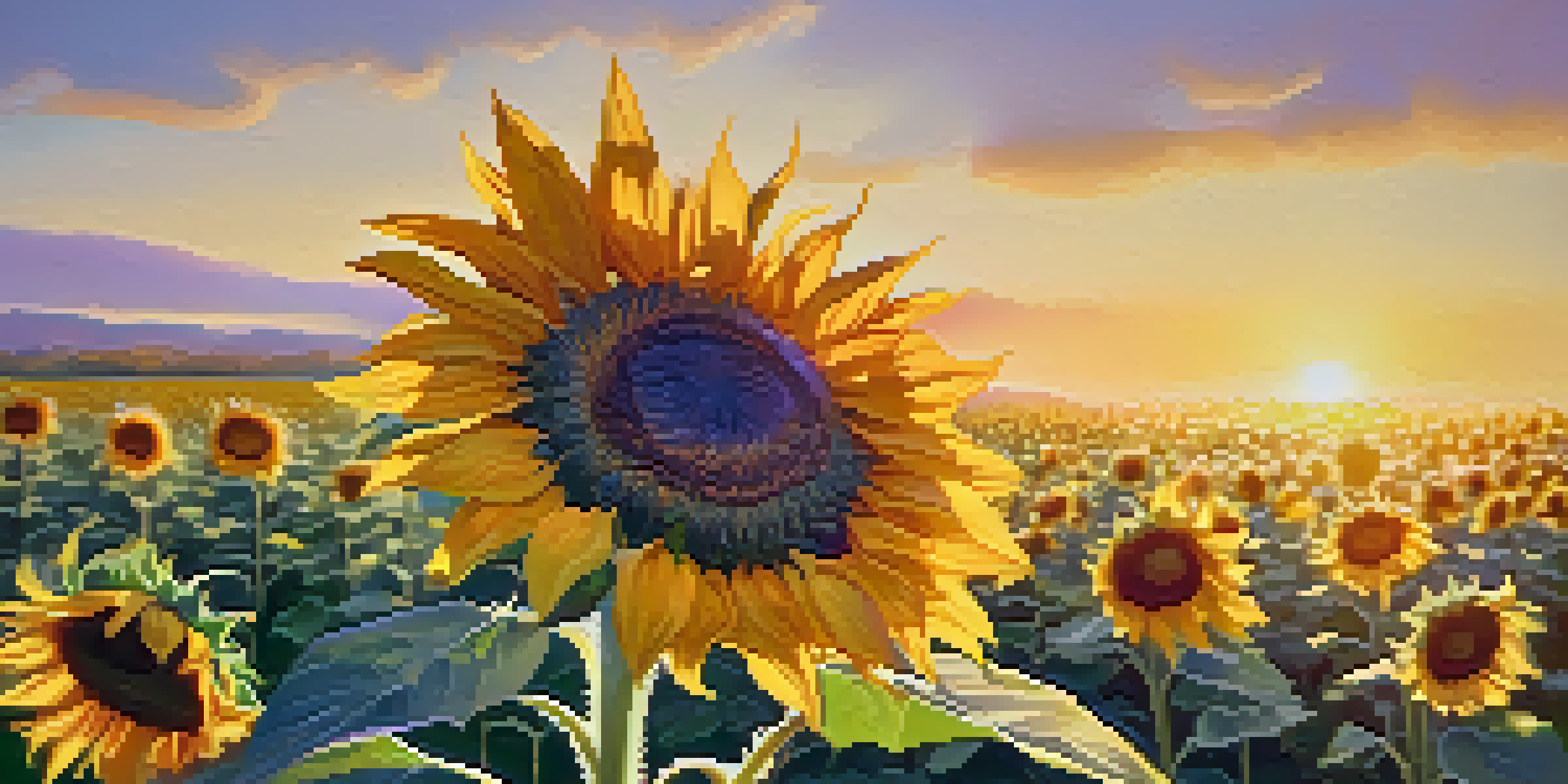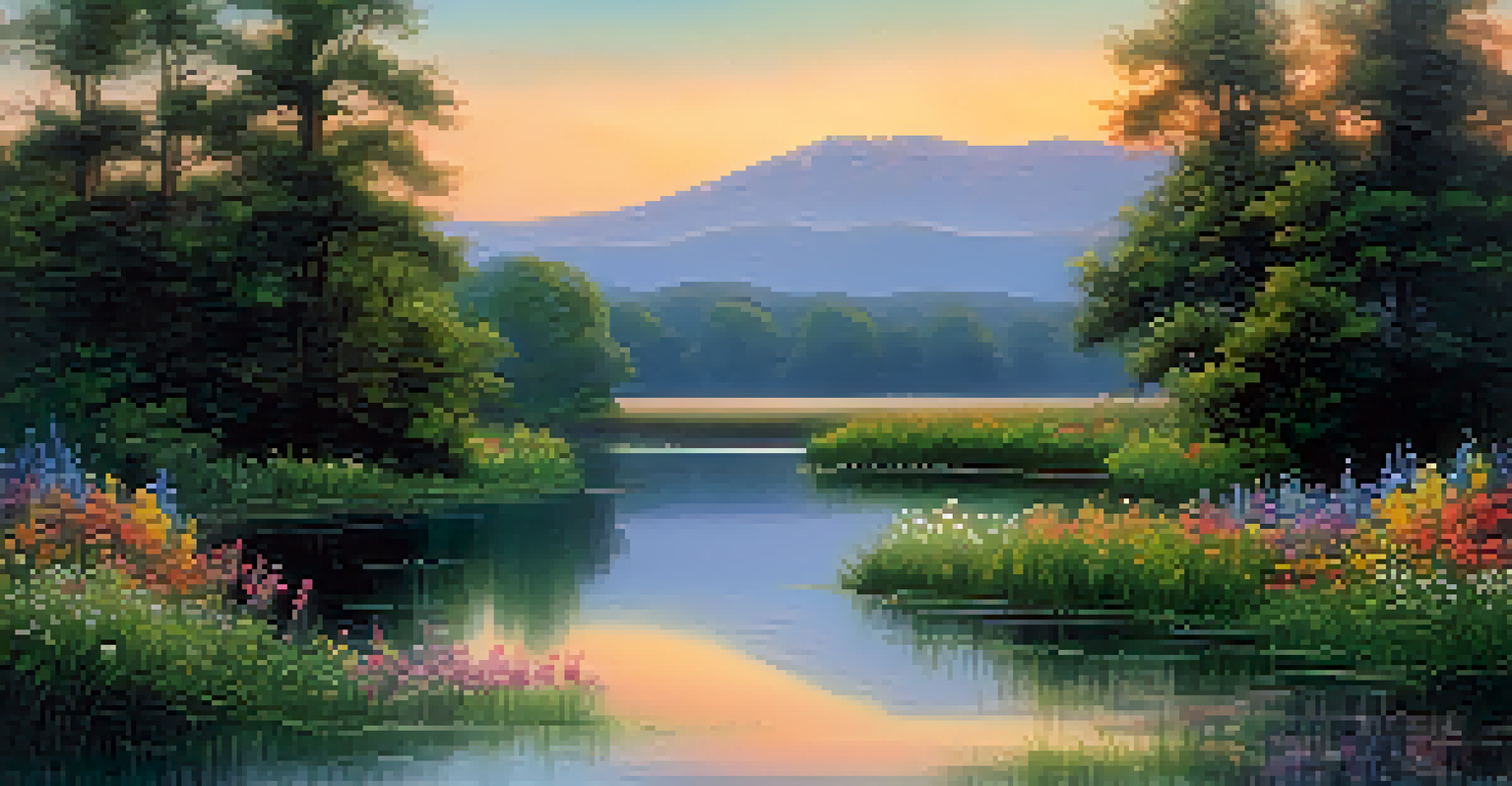The Influence of Flora on Artistic Techniques and Styles

Nature as the Muse: Flora in Art History
Throughout history, artists have often turned to nature for inspiration. Flora, in particular, has played a significant role in shaping artistic expression. From the delicate petals of a flower to the sturdy branches of a tree, plants have been a source of beauty and symbolism in countless works of art.
Nature is not a place to visit. It is home.
Consider how the Impressionists, like Claude Monet, celebrated the natural world by capturing the fleeting effects of light on flowers and landscapes. Their techniques, such as loose brushwork and vibrant colors, were directly influenced by their observations of flora. This connection between plants and art demonstrates that nature can profoundly impact not only subject matter but also artistic techniques.
Moreover, many cultures have employed botanical motifs to convey deeper meanings, as seen in traditional Japanese art. Here, cherry blossoms symbolize the transient nature of life, teaching artists to appreciate beauty in impermanence. This intertwining of flora and artistic expression reveals how plants can transcend mere decoration, urging artists to convey complex emotions and themes.
Botanical Influences on Artistic Techniques
The physical characteristics of flora have influenced various artistic techniques. For example, the intricate details of leaf patterns can inspire artists to experiment with texture and form in their work. Techniques like stippling or cross-hatching can replicate the delicate veins of leaves, giving art a lifelike quality.

Furthermore, the study of botanical forms has led to the development of specific styles, such as Art Nouveau. This movement embraced organic shapes and flowing lines, often drawing directly from the curves and shapes found in plants. Artists like Alphonse Mucha skillfully integrated these elements into their work, creating a harmonious blend of nature and design.
Flora Inspires Artistic Techniques
The physical characteristics of plants influence various artistic styles and techniques, allowing artists to capture their beauty authentically.
In addition, the colors found in flora can inspire palettes in painting and design. The vibrant hues of a sunset reflected in flowers can guide artists in selecting colors that evoke certain moods or feelings. This thoughtful approach to color selection can enhance the visual impact of a piece, allowing flora to influence not just the subject but also the overall technique.
Symbolism of Flora in Artistic Expression
Flora is rich with symbolism, and this depth often finds its way into artistic expression. Different plants carry varied meanings across cultures; for instance, roses symbolize love, while lilies often represent purity. By incorporating these symbols, artists can convey complex ideas and emotions without needing words.
Art is the most beautiful of all lies; it is the most truthful of all truths.
Take, for example, the works of Vincent van Gogh, who frequently used sunflowers to express joy and vitality. His bold brush strokes and vibrant yellows not only celebrate the beauty of the flower but also evoke a sense of warmth and happiness. This use of flora as a symbol allows viewers to connect with the artwork on a deeper level.
Moreover, in contemporary art, artists continue to explore the symbolism of plants, using them to comment on environmental issues or personal narratives. This ongoing dialogue between flora and artistic expression showcases how plants can serve as both a visual motif and a powerful storytelling device.
Floral Patterns in Textile and Design Arts
Floral patterns have a long-standing presence in textile and design arts, serving as timeless sources of inspiration. From wallpaper to fashion, the beauty of flowers has been translated into various materials, creating a rich tapestry of design. These patterns often evoke feelings of freshness and vitality, making them popular choices in home décor and clothing.
For instance, the iconic floral prints of designer William Morris during the Arts and Crafts Movement reflect a deep appreciation for nature. His intricate patterns not only celebrated botanical beauty but also promoted craftsmanship and sustainability. Such designs have stood the test of time, continuing to influence contemporary textile design.
Flora Symbolizes Deep Emotions
Different plants carry unique meanings that artists use to convey complex ideas and feelings in their works.
Additionally, floral motifs can be adapted to modern aesthetics, demonstrating their versatility. Designers often blend traditional floral patterns with contemporary elements, creating unique pieces that resonate with a wide audience. This fusion of styles highlights the enduring influence of flora in the world of art and design.
The Role of Flora in Photography
In photography, flora serves as an important subject that can evoke strong emotions and capture the essence of a moment. Photographers often use plants to create stunning compositions that highlight nature's beauty. The interplay of light and shadow on flowers can produce striking images, showcasing the intricate details that might otherwise go unnoticed.
Consider the work of renowned photographers like Edward Weston, who captured the form and texture of vegetables and flowers in a way that elevated them to fine art. His black-and-white images reveal the sculptural qualities of flora, transforming simple subjects into profound works of art. This approach demonstrates how flora can inspire photographers to experiment with different techniques and perspectives.
Moreover, contemporary photographers often use flora to comment on environmental issues, using their art as a form of activism. By highlighting the beauty of endangered plants or ecosystems, they raise awareness about the importance of conservation. In this way, flora not only enhances artistic expression but also serves as a catalyst for meaningful conversations.
Flora in Sculpture: A Three-Dimensional Perspective
Sculpture offers a unique opportunity to explore the influence of flora in three dimensions. Artists often draw inspiration from the organic forms of plants, translating their beauty into sculptural works. The fluid lines and intricate details of flowers and leaves can lead to stunning interpretations in materials like stone, metal, or clay.
A great example of this is the work of botanically inspired sculptor Andy Goldsworthy, who creates ephemeral art using natural materials found in the environment. His sculptures, made from leaves, stones, and branches, encapsulate the essence of flora while emphasizing the transient nature of life. This approach invites viewers to appreciate the beauty of the natural world in new and innovative ways.
Modern Art Reimagines Flora
Contemporary artists are exploring innovative interpretations of flora, often addressing environmental themes through unconventional materials.
Additionally, the use of flora in sculpture can convey themes of growth, decay, and regeneration. By incorporating plant elements into their works, sculptors can explore the cycle of life and the interconnectedness of nature and humanity. This deeper exploration adds layers of meaning to their art, showcasing how flora can influence not only aesthetics but also conceptual depth.
Modern Interpretations of Flora in Contemporary Art
In contemporary art, the representation of flora has taken on new forms and meanings. Artists are increasingly experimenting with unconventional materials and techniques to express their connection to nature. This modern interpretation often challenges traditional views, pushing the boundaries of how flora is perceived in art.
For instance, artists like Yayoi Kusama use floral patterns in immersive installations that invite viewers to engage with their surroundings. Her work, which often features vibrant colors and repetitive floral motifs, creates a sense of wonder and reflection. This playful yet profound approach showcases how contemporary artists are reimagining flora in innovative ways.

Furthermore, the rise of eco-art has led to a renewed focus on environmental themes, with many artists using flora to address pressing ecological issues. By incorporating live plants or natural materials into their work, these artists create a dialogue about sustainability and our relationship with nature. This evolution in artistic interpretation underscores the enduring influence of flora, inspiring a new generation of creators to engage with the natural world.